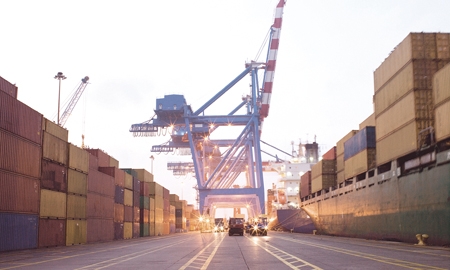On February 4, the Diadema, a giant container vessel laden with cargo, docked in Indonesia’s busiest harbor in North Jakarta.
The arrival of the Maersk Line mega-ship, carrying more than 4,500 standard-size containers, marked a new stage of development for Tanjung Priok port, Indonesia’s biggest seaport.
It was the first time that the port, which handles 75% of the nation’s total container traffic, was able to accommodate a ship of such a size. Previously, only vessels of up to 3,000 twenty-foot equivalent unit containers (TEUs) could dock there.
Tanjung Priok port is a bustling center for West Java exports and transshipments with other islands in Southeast Asia and the South Pacific. Export and import activity has surged, container traffic has been growing at an average annual rate of 26%, and last year exceeded the port’s capacity of 5 million TEUs.
February was also the month that state-owned Pelindo II, the operator of Tanjung Priok port and 11 other harbors, relaunched itself as
IPC –
Indonesian Port Corporation, adopting the motto ‘Energizing Trade, Energizing Indonesia.’
“We need to have very efficient and productive ports... The ports are the gates to Indonesia for the world, and vice versa.” Richard Joost Lino, President Director of the Indonesia Port Corporation |
IPC’s President Director Richard Joost Lino says the arrival of the Diadema – now making a regular weekly call – demonstrates to the big international shipping lines the confidence they can now have in Indonesia’s principal port. He wants Tanjung Priok to become a regional hub in the next three years, and be internationally recognized for its efficiency.
“We want to be a world-class port operator,” he says. “In the near future, we expect to have an average increase of at least one million TEUs of containers per year – so by the end of this year, hopefully, we will reach 6 million TEU containers,” he says.
Making this possible will continue to require, considerable cost and effort. In recent years, IPC has invested nearly $250 million in upgrading Tanjung Priok port, which now operates 24-hours a day.
New container loading cranes have been installed, an 1,000-square meter plot of land in Terminal 3 has been converted into an international container terminal, and a new $11.55 million information technology system is to be installed to ease congestion by monitoring vessel traffic online. The system will also be installed at Palembang, Pontianak, and Jambi ports in 2013.
Mr. Lino says, “The system enables ship operators to know exactly when and in which terminal their ships will dock. They can plan their shipping properly to maximize their resources, and logistics costs will be dramatically reduced.”
Indonesia’s logistics costs are among the highest in any Southeast Asian country.
“As a state-owned enterprise, IPC must help this country to reduce logistics costs to make the economy grow faster,” says Mr. Lino.
He argues that if the ports can be made cheaper and more efficient transportation of goods can be shifted from Indonesia’s congested roads to sea transportation.
“We need to have very efficient and productive ports. If your port is efficient, you will increase your ship capacity. The ports are the gates to Indonesia for the world, and vice versa.”
Based in Jakarta-based state-owned IPC runs 11 other Indonesian ports in addition to Tanjung Priok. Since it began its revitalization drive in 2008 under Mr. Lino’s leadership, revenue has doubled and profits increased almost four-fold.
In 2011, the increase in cargo traffic took the port operator’s total revenues to 5.14 trillion rupiah ($570 million), an increase of 41.46%, compared to 2010. Net profit increased by 33% in the same period, reaching 1.63 trillion rupiah.
This year, the company is targeting earnings of up to 6 trillion rupiah, and net profit of 1.7 trillion rupiah. Six subsidiary companies are being established to further improve efficiency at the ports and accelerate infrastructure development.
IPC increased its investment in port facilities by 36% to 1.5 trillion rupiah in 2011. This year it expects invest 4.5 trillion rupiah.
A substantial amount of that will go towards construction of North Jakarta’s New Priok Container Terminal, needed to relieve the mounting pressure on Tanjung Priok port. Phase I will be completed by the end of the first quarter of 2014, and the rest of the project in 2017 at a cost of approximately $2 billion.
Work will also start this year on the development of Sorong Container Port in West Papua. The port should become operational by 2014.
Significant investment is also being made in staff training. “We have invested $50 million to prepare our best people to be world-class managers,” says Mr. Lino.

0 COMMENTS